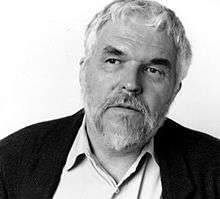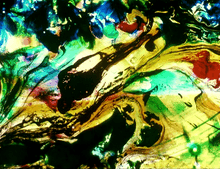Stan Brakhage
| Stan Brakhage | |
|---|---|
 | |
| Born |
Robert Sanders January 14, 1933 Kansas City, Missouri |
| Died |
March 9, 2003 (aged 70) Victoria, British Columbia |
| Nationality | United States |
| Known for | Experimental film |
James Stanley Brakhage (/ˈbrækədʒ/ BRAK-əj; January 14, 1933 – March 9, 2003), better known as Stan Brakhage, was an American non-narrative filmmaker. He is considered to be one of the most important figures in 20th-century experimental film.
Over the course of five decades, Brakhage created a large and diverse body of work, exploring a variety of formats, approaches and techniques that included handheld camerawork, painting directly onto celluloid, fast cutting, in-camera editing, scratching on film, collage film and the use of multiple exposures. Interested in mythology and inspired by music, poetry, and visual phenomena, Brakhage sought to reveal the universal in the particular, exploring themes of birth, mortality,[1] sexuality,[2] and innocence.[2]
Brakhage's films are often noted for their expressiveness[2][3] and lyricism.[2][4]
Biography
Born Robert Sanders in Kansas City, Missouri on January 14, 1933, Brakhage was adopted and renamed three weeks after his birth by Ludwig and Clara Brakhage.
As a child, Brakhage was featured on radio as a boy soprano and sang in church choirs and as a soloist at other events. He was raised in Denver, Colorado, where he attended high school with the filmmaker Larry Jordan and the musicians Morton Subotnick and James Tenney.[4] Together, Brakhage, Jordan, Tenney and Subotnick formed a drama group called the Gadflies.
Brakhage briefly attended Dartmouth College on a scholarship[4] before dropping out to make films. He completed his first film, Interim, at the age of 19; the music for the film was composed by his school friend James Tenney. In 1953, Brakhage moved to San Francisco to attend the San Francisco Art Institute, then called the California School of the Arts. He found the atmosphere in San Francisco more rewarding,[4] associating with poets Robert Duncan and Kenneth Rexroth, but did not complete his education, instead moving to New York City in 1954. There he met a number of notable artists, including Maya Deren (in whose apartment he briefly lived[4]), Willard Maas, Jonas Mekas, Marie Menken, Joseph Cornell, and John Cage. Brakhage would collaborate with the latter two, making two films with Cornell (Gnir Rednow and Centuries of June) and using Cage's music for the soundtrack of his first color film, In Between.
Brakhage spent the next few years living in near poverty,[4] depressed about what he saw as the failure of his work. He briefly considered suicide.[4] While living in Denver, Brakhage met Mary Jane Collom (see Jane Wodening), whom he married in late 1957. Known as Jane Brakhage, she became his first wife. Brakhage tried to make money on his films, but had to take a job making industrial shorts to support his family. In 1958, Jane gave birth to the first of the five children they would have together, an event Brakhage recorded for his 1959 film Window Water Baby Moving.
The 1960s and beginning of recognition
When Brakhage's early films had been exhibited in the 1950s, they had often been met with derision,[4] but in the early 1960s Brakhage began to receive recognition in exhibitions and film publications, including Film Culture, which gave awards to several of his films, including The Dead, in 1962. The award statement, written by Jonas Mekas, a critic who would later become an influential experimental filmmaker in his own right, cited Brakhage for bringing to cinema "an intelligence and subtlety that is usually the province of the older arts."[4]
From 1961 to 1964, Brakhage worked on a series of 5 films known as the Dog Star Man cycle. The Brakhages moved to Lump Gulch, Colorado in 1964, though Brakhage continued to make regular visits to New York. During one of those visits, the 16mm film equipment he had been using was stolen. Brakhage couldn't afford to replace it, instead opting to buy cheaper 8mm film equipment. He soon began working in the format, producing a 30-part cycle of 8mm films known as the Songs from 1964 to 1969. The Songs include one of Brakhage's most acclaimed films, 23rd Psalm Branch, a response to the Vietnam War and its presentation in the mass media.
Brakhage began teaching film history and aesthetics at the School of the Art Institute of Chicago in 1969, commuting from his home in Colorado.
1970s and 1980s

Brakhage explored further approaches to filmmaking in the 1970s. In 1971, he completed a set of three films inspired by public institutions in the city of Pittsburgh. These three films--Eyes, about the city police, Deus Ex, filmed in a hospital, and The Act of Seeing with One's Own Eyes, depicting autopsy—are collectively known as "The Pittsburgh Trilogy."[5] In 1974, Brakhage made the feature-length Text of Light, consisting entirely of images of light refracted in a glass ashtray. In 1979, he experimented with Polavision, a format marketed by Polaroid, making about five 2 1⁄2 minute films. The whereabouts of these films are now unknown. He continued his visual explorations of landscape and the nature of light and thought process, and through the late 70s and early 80s produced filmic equivalents of what he termed "moving visual thinking" in several series of photographic abstractions known as the Roman, Arabic, and Egyptian series.
Stan Brakhage taught at the University of Colorado in Boulder off and on, in the late 1970s and early 1980s. In 1986, Brakhage separated from Jane, and in 1989 he married his second wife, Marilyn. The two would have two children together. In the late 1980s, Brakhage returned to making sound films, with the four-part Faustfilm cycle, and also completed the hand-painted film, The Dante Quartet.
1990s – 2000s and death
Brakhage remained extremely productive through the last two decades of his life, sometimes working in collaboration with other filmmakers, including his University of Colorado colleague Phil Solomon. Several more sound films were completed, including Passage Through: A Ritual, edited to the music of Philip Corner, and Christ Mass Sex Dance and Ellipses Reel 5, both with music by James Tenney. He also produced the major meditations on childhood, adolescence, aging and mortality collectively known as the "Vancouver Island Quartet," as well as numerous hand-painted works.
Brakhage was diagnosed with bladder cancer in 1996, and his bladder was removed. The surgery seemed successful, but the cancer eventually returned. In a video interview in 2002, he explained that his cancer was caused by the toxicity of the aniline dyes he had used to paint directly onto film.[6]
Brakhage retired from teaching and moved to Canada in 2002, settling with his second wife Marilyn and their two sons in Victoria, British Columbia. Brakhage died there on March 9, 2003, aged 70. The last footage Brakhage shot has been made available under the title Work in Progress. At the time of his death, Brakhage was also working on the Chinese Series, made by scratching directly on to film.
Though not a practicing Christian[7] during his adulthood, Brakhage requested a traditional Anglican service. The funeral was attended largely by family members, as well as a few friends from the filmmaking world, and included a performance of J.S. Bach's Toccata and Fugue in D Minor.
Influence
In 1961, Jonas Mekas wrote that Brakhage is “one of the four or five most authentic film artists working in cinema anywhere, and perhaps the most original filmmaker in America today,”[8] Among Brakhage's students were Eric Darnell, the director of Antz, as well as the creators of South Park, Matt Stone and Trey Parker, and he is featured in their student film Cannibal! The Musical.[9]
Martin Scorsese's Last Temptation of Christ uses Brakhage's painted film style to depict the death of Jesus on the cross.[10] Scorsese has framed samples of Brakhage's films on his office wall.[11]
The work of contemporary film and video artist Raymond Salvatore Harmon (1974- ) has been compared to Brakhage's abstract films.[12]
The credits of the film Seven (1995), with their scratched emulsion, rapid cutaways and bursts of light are in Brakhage's style.[13]
The opening track of Stereolab's album Dots and Loops (1997), "Brakhage," is named after him.[14]
Sonic Youth, joined by percussionist Tim Barnes, played along with silent Stan Brakhage films at a 2003 benefit show for Anthology Film Archives. The live recording is available as SYR6: Koncertas Stan Brakhage Prisiminimui.[15]
The concluding credits to The Jacket (2005) are an homage, the background imitating his Mothlight.
The Intro to David E. Kelley's Law Series The Practice is influenced by Brakhage.
The opening titles to the BBC television series The Living and the Dead (2016) use an excerpt from Mothlight.[16]
Episode 8 of "Twin Peaks: the revival" includes a sequence heavily reminiscent of Brakhage.
Filmography
The Brakhage films, comprising his edited originals, intermediate elements, and other original material, are housed at the Academy of Motion Picture Arts and Sciences Film Archive, where a long-term project is underway to preserve and restore his entire film output.[17]
Writings
Brakhage wrote a number of books about films, including Metaphors on Vision (1963), A Moving Picture Giving and Taking Book (1971), Film Biographies (1977, Turtle Island Books) and the posthumously published Telling Time: Essays of a Visionary Filmmaker (2003).
The entire Brakhage collection, including film prints, audio recordings, letters, and other writings, is currently housed at The Brakhage Center for the Media Arts at the University of Colorado, Boulder.
References
- ↑ Rosenbaum, Jonathan. "The Act of Seeing with One's Own Eyes". Chicago Reader. Retrieved 2011-03-26.
- 1 2 3 4 Senses of Cinema: Stan Brakhage
- ↑ Before the Beginning Was the Word: Stan Brakhage's by Paul Arthut
- 1 2 3 4 5 6 7 8 9 James, David E. (July 13, 2005). Stan Brakhage: Filmmaker (Hardcover ed.). New York, NY: Temple UP. ISBN 978-1-59213-271-3.
- ↑ https://www.timeout.com/newyork/film/stan-brakhage-the-pittsburgh-trilogy
- ↑ Stan Brakhage interview with Colin Still, 2002, "By Brakhage: An Anthology: Volume 1" Criterion Collection, disc 2. Released 2004.
- ↑ Solomon, Phil (March 20, 2003). "Account of Stan Brakhage's Funeral by Phil Solomon". fredcamper.com. Retrieved 2011-03-26.
- ↑ Koehler, Robert, (11 March 2003). "Stan Brakhage" Variety. Retrieved 1 April 2014.
- ↑ Walker, Jesse (February 2001). "Stan Brakhage's Dog Star Man Show". Reason.com. Retrieved 27 July 2015.
- ↑ Hynes, Eric. "The Last Temptation of Christ". Retrieved 2014-12-24.
- ↑ Elliott, Marshall (24 December 2014). "Stan Brakhage quotes from my old college notes". Brakhage Said. Retrieved 27 July 2015.
- ↑ "Chicago Underground Trio: Chronicle"
- ↑ "Experimental Filmmaker Stan Brakhage Has Passed Away". www.aintitcool.com/. Retrieved August 15, 2012.
- ↑ Stark, Jeff (22 September 1999). "Surrealist manifesto". Salon.com. Retrieved 27 July 2015.
- ↑ Linhardt, Alex (15 January 2006). "Sonic Youth: SYR6: Koncertas Stan Brakhage Prisiminimui : Album review". Pitchfork Media. Retrieved 16 Jul 2012.
- ↑ Radford, Ivan (15 Jun 2016) "The Living and the Dead: A horror show to savour" Vodzilla.co
- ↑ "Preserved Projects". Academy Film Archive.
External links
- Filmography by Fred Camper.
- Stan Brakhage on IMDb
- Ocular Spectacular
- On Stan Brakhage
- A Conversation Between Jonas Mekas and Stan Brakhage
- Stan Brakhage bibliography (via UC Berkeley)
- Directory of links to pages about Brakhage
- Rental of Brakhage's films in 16mm and other formats
- Senses of Cinema: Great Directors Critical Database
- They Shoot Pictures, Don't They?
- Magic & Images/ Images & Magic, by David Levi Strauss —an opening paper for a conference at Princeton University, "Magic and the American Avant-Garde Cinema", March 11, 2006.
- The Flame is Ours The Letters of Stan Brakhage and Michael McClure1961-1978 Edited by Christopher Luna at Big Bridge 15